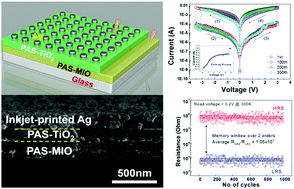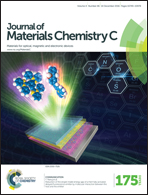Resistive switching characteristics of all-solution-based Ag/TiO2/Mo-doped In2O3 devices for non-volatile memory applications†
Abstract
In this paper, we demonstrate the fabrication of electrochemical-metallization-based resistive switching random access memory (ECM-based ReRAM) devices with an Ag/TiO2/Mo-doped In2O3 configuration through a simple solution-based process. Both TiO2 and Mo-doped In2O3 layers in the memory device were spin-coated with polymer-assisted-solution inks formulated by coordinating the Ti-, Mo-, and In-complex with a water-soluble polymer. The Ag top electrode was inkjet-printed with Ag nanoparticle ink. The memory devices fabricated by all-solution processes demonstrated excellent bipolar switching behavior with a high resistive switching ratio of 103, an excellent endurance of more than 1000 cycles, a stable retention time greater than 104 s at elevated temperatures, and a fast programming speed of 250 ns. The characterization results of the conduction mechanism in high and low resistive states indicate that the resistive switching is caused by the formation and rupture of nano-sized Ag conducting filaments in the TiO2 layer. These results suggest the potential of all-solution-based ECM-based ReRAM for developing future nonvolatile memory devices at low cost.


 Please wait while we load your content...
Please wait while we load your content...